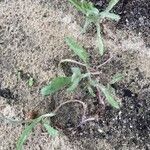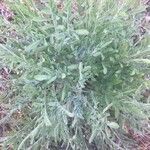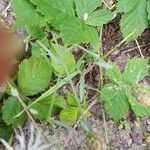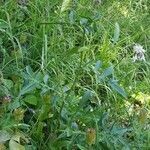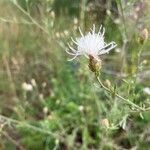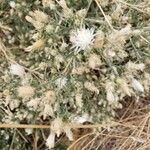Herbs 15-50 cm tall, biennial. Stems erect or diffuse, branched from base; stem and branches densely strigose and sparsely arachnoid. Leaves adaxially scabrous. Basal and lower stem leaves petiolate; leaf blade bipinnatisect. Middle stem leaves sessile. Upper leaves sessile, linear, margin entire. Capitula numerous, paniculate at end of stem and branches. Involucre ovoid-cylindric to cylindric, 3-5 mm in diam. Phyllaries in 5 or 6 rows; outer and middle phyllaries lanceolate to elliptic, 3-7 × ca. 1.5 mm; appendage of outer and middle phyllaries straw-colored, with 1-5 pectinately arranged spines on each side ending in a 2-4 mm arcuate-patent spine; inner phyllaries linear, ca. 8 × 1 mm; appendage of inner phyllaries scarious. Sterile florets few, as long as bisexual ones, not radiant; bisexual florets ca. 12. Corolla white. Achene dark brown with paler stripes, narrowly ovoid, ca. 2 mm, sparsely pilose, apex with a minute inconspicuous smooth apical rim. Pappus absent. Fl. and fr. Sep. 2n = 18, 36.
Diffusely branched annual or biennial 1–6 dm; herbage sparsely scabrous-puberulent under the thin and deciduous arachnoid tomentum; lvs small, ± pinnatifid, the lower ones deciduous, the reduced ones of the infl mostly entire; heads numerous, narrow; invol 8–10 mm, the middle and outer bracts coarsely pectinate or weakly spinose-ciliate, and tipped with a definite slender spine 1.5–4 mm; fls few, white, seldom yellowish or pinkish or red, the marginal ones not enlarged; pappus none; 2n=18. A weed in waste places, native to se. Europe, and now found here and there in our range. July–Sept.
